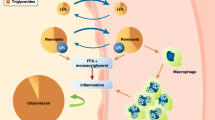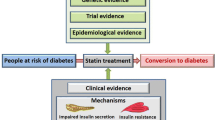Abstract
Type 2 diabetes is a global epidemic contributing to significant cardiovascular morbidity and mortality. The high prevalence of cardiovascular disease can largely be attributed to the metabolic syndrome with its multiple cardiovascular risk factors, including central obesity, hypertension, glucose intolerance, chronic inflammation, and dyslipidemia. The peroxisome proliferator-activated receptor-ã agonists, the thiazolidinediones, may potentially correct the inflammatory disarray, endothelial dysfunction, dyslipidemia, and plaque vulnerability associated with diabetic cardiovascular disease through their effects on insulin resistance and fat metabolism, yet they can also exacerbate congestive heart failure. This review summarizes basic science, animal, and human data on the effects of thiazolidinediones on cardiovascular disease.
Similar content being viewed by others
References and Recommended Reading
Bonow RO, Gheorghiade M: The diabetes epidemic: a national and global crisis. Am J Med 2004, 116(suppl):10S.
Haffner SM, Lehto S, Ronnemaa T, et al.: Mortality from coronary heart disease in subjects with type 2 diabetes and in nondiabetic subjects with and without prior myocardial infarction. N Engl J Med 1998, 339:229–334.
Kramer D, Raji A, Plutzky J. Prediabetes mellitus and its links to atherosclerosis. Curr Diab Rep 2003, 3:11–18.
Stary HC, Chandler AB, Glagov S, et al.: A definition of initial, fatty streak, and intermediate lesions of atherosclerosis. A report from the Committee on Vascular Lesions of the Council on Arteriosclerosis, American Heart Association. Circulation 1994, 89:2462–2478.
Bonora E, Formentini G, Calcaterra F, et al.: HOMAestimated insulin resistance is an independent predictor of cardiovascular disease in type 2 diabetic subjects: prospective data from the Verona Diabetes Complications Study. Diabetes Care 2002, 25:1135–1141.
Carmena R: Type 2 diabetes, dyslipidemia, and vascular risk: rationale and evidence for correcting the lipid imbalance. Am Heart J 2005, 150:859–870.
Verges B: New insight into the pathophysiology of lipid abnormalities in type 2 diabetes. Diabetes Metab 2005, 31:429–439.
Dandona P, Aljada A, Chaudhuri A, et al.: Metabolic syndrome: a comprehensive perspective based on interactions between obesity, diabetes, and inflammation. Circulation 2005, 111:1448–1454.
Plutzky J: The vascular biology of atherosclerosis. Am J Med 2003, 115(suppl 8A):55S-61S.
Staels B: PPARgamma and atherosclerosis. Curr Med Res Opin 2005, 21(supp l):S13-S20. This is an interesting and fairly comprehensive review of the many effects of PPAR-ã on the atherosclerotic process.
Mather KJ, Lteif A, Steinberg HO, et al.: Interactions between endothelin and nitric oxide in the regulation of vascular tone in obesity and diabetes. Diabetes 2004, 53:2060–2066.
Marx N, Froehlich J, Siam L, et al.: Antidiabetic PPAR gamma-activator rosiglitazone reduces MMP-9 serum levels in type 2 diabetic patients with coronary artery disease. Arterioscler Thromb Vasc Biol 2003, 23:283–288.
Thogersen AM, Jansson JH, Boman K, et al.: High plasminogen activator inhibitor and tissue plasminogen activator levels in plasma precede a first acute myocardial infarction in both men and women: evidence for the fibrinolytic system as an independent primary risk factor. Circulation 1998, 98:2241–2247.
Bruemmer D, Law RE: Thiazolidinedione regulation of smooth muscle cell proliferation. Am J Med 2003, 115(suppl 8A):87S-92S.
Staels B, Fruchart JC: Therapeutic roles of peroxisome proliferator-activated receptor agonists. Diabetes 2005, 54:2460–2470.
Chinetti-Gbaguidi G, Fruchart JC, Staels B: Role of the PPAR family of nuclear receptors in the regulation of metabolic and cardiovascular homeostasis: new approaches to therapy. Curr Opin Pharmacol 2005, 5:177–183.
Barish GD, Evans RM: PPARs and LXRs: atherosclerosis goes nuclear. Trends Endocrinol Metab 2004, 15:158–165.
Knouff C, Auwerx J: Peroxisome proliferator-activated receptor-gamma calls for activation in moderation: lessons from genetics and pharmacology. Endocr Rev 2004, 25:899–918.
Tontonoz P, Nagy L, Alvarez JG, et al.: PPARgamma promotes monocyte/macrophage differentiation and uptake of oxidized LDL. Cell 1998, 93:241–252.
Cock TA, Houten SM, Auwerx J: Peroxisome proliferatoractivated receptor-gamma: too much of a good thing causes harm. EMBO Rep 2004, 5:142–147.
Nagy L, Tontonoz P, Alvarez JG, et al.: Oxidized LDL regulates macrophage gene expression through ligand activation of PPARgamma. Cell 1998, 93:229–240.
Jiang C, Ting AT, Seed B: PPAR-gamma agonists inhibit production of monocyte inflammatory cytokines. Nature 1998, 391:82–86.
Zhang L, Chawla A: Role of PPARgamma in macrophage biology and atherosclerosis. Trends Endocrinol Metab 2004, 15:500–505.
Delerive P, Martin-Nizard F, Chinetti G, et al.: Peroxisome proliferator-activated receptor activators inhibit thrombin-induced endothelin-1 production in human vascular endothelial cells by inhibiting the activator protein-1 signaling pathway. Circ Res 1999, 85:394–402.
Calnek DS, Mazzella L, Roser S, et al.: Peroxisome proliferator-activated receptor gamma ligands increase release of nitric oxide from endothelial cells. Arterioscler Thromb Vasc Biol 2003, 23:52–57.
Diep QN, El Mabrouk M, Cohn JS, et al.: Structure, endothelial function, cell growth, and inflammation in blood vessels of angiotensin II-infused rats: role of peroxisome proliferator-activated receptor-gamma. Circulation 2002, 105:2296–2302.
Zirlik A, Leugers A, Lohrmann J, et al.: Direct attenuation of plasminogen activator inhibitor type-1 expression in human adipose tissue by thiazolidinediones. Thromb Haemost 2004, 91:674–682.
Barak Y, Nelson MC, Ong ES, et al.: PPAR gamma is required for placental, cardiac, and adipose tissue development. Mol Cell 1999, 4:585–595.
Rangwala SM, Rhoades B, Shapiro JS, et al.: Genetic modulation of PPARgamma phosphorylation regulates insulin sensitivity. Dev Cell 2003, 5:657–663.
Yu S, Matsusue K, Kashireddy P, et al.: Adipocyte-specific gene expression and adipogenic steatosis in the mouse liver due to peroxisome proliferator-activated receptor gamma1 (PPARgamma1) overexpression. J Biol Chem 2003, 278:498–505.
Corti R, Osende JI, Fallon JT, et al.: The selective peroxisomal proliferator-activated receptor-gamma agonist has an additive effect on plaque regression in combination with simvastatin in experimental atherosclerosis: in vivo study by high-resolution magnetic resonance imaging. J Am Coll Cardiol 2004, 43:464–473.
Li AC, Brown KK, Silvestre MJ, et al.: Peroxisome proliferator-activated receptor gamma ligands inhibit development of atherosclerosis in LDL receptor-deficient mice. J Clin Invest 2000, 106:523–531.
Chawla A, Boisvert WA, Lee CH, et al.: A PPAR gamma-LXRABCA1 pathway in macrophages is involved in cholesterol efflux and atherogenesis. Mol Cell 2001, 7:161–171.
Igarashi M, Hirata A, Yamaguchi H, et al.: Characterization of an inhibitory effect of pioglitazone on balloon-injured vascular smooth muscle cell growth. Metab Clin Exp 2001, 50:955–962.
Abdelrahman M, Sivarajah A, Thiemermann C: Beneficial effects of PPAR-gamma ligands in ischemia-reperfusion injury, inflammation and shock. Cardiovasc Res 2005, 65:772–781.
Carey DG, Cowin GJ, Galloway GJ, et al.: Rosiglitazone increases insulin sensitivity and reduces factors associated with insulin resistance in type 2 diabetics. Diabetes Res Clin Pract 2000, 50(suppl 1):64–65.
Marx N, Imhof A, Froehlich J, et al.: Effect of rosiglitazone treatment on soluble CD40L in patients with type 2 diabetes and coronary artery disease. Circulation 2003, 107:1954–1957.
Peters Harmel AL, Kendall DM, Buse JB, et al.: Impact of adjunctive thiazolidinedione therapy on blood lipid levels and glycemic control in patients with type 2 diabetes. Curr Med Res Opin 2004, 20:215–223.
Diamant M, Heine RJ: Thiazolidinediones in type 2 diabetes mellitus: current clinical evidence. Drugs 2003, 63:1373–1405.
Goldberg RB, Kendall DM, Deeg MA, et al.: A comparison of lipid and glycemic effects of pioglitazone and rosiglitazone in patients with type 2 diabetes and dyslipidemia. Diabetes Care 2005, 28:1547–1554.
Bakris G, Viberti G, Weston WM, et al.: Rosiglitazone reduces urinary albumin excretion in type II diabetes. J Hum Hypertens 2003, 17:7–12.
Nakamura T, Ushiyama C, Shimada N, et al.: Comparative effects of pioglitazone, glibenclamide, and voglibose on urinary endothelin-1 and albumin excretion in diabetes patients. J Diabetes Complications 2000, 14:250–254.
Koshiyama H, Shimono D, Kuwamura N, et al.: Rapid communication: inhibitory effect of pioglitazone on carotid arterial wall thickness in type 2 diabetes. J Clin Endocrinol Metabol 2001, 86:3452–3426.
Xiang AH, Peters RK, Kjos SL, et al.: Effect of pioglitazone on pancreatic beta-cell function and diabetes risk in Hispanic women with prior gestational diabetes. Diabetes 2006, 55:517–522.
Secondary prevention of macrovascular events in patients with type 2 diabetes in the PROactive Study (PROspective pioglitAzone Clinical Trial in macroVascular Events): a randomized controlled trial. Proactive Investigators [no authors listed]. Lancet 2005, 366:1279–1289.
Miles PD, Barak Y, He W, et al.: Improved insulin-sensitivity in mice heterozygous for PPAR-gamma deficiency. J Clin Invest 2000, 105:287–292.
Rieusset J, Touri F, Michalik L, et al.: A new selective peroxisome proliferator-activated receptor gamma antagonist with antiobesity and antidiabetic activity. Mol Endocrinol 2002, 16:2628–2644.
Rocchi S, Picard F, Vamecq J, et al.: A unique PPARgamma ligand with potent insulin-sensitizing yet weak adipogenic activity. Mol Cell 2001, 8:737–747.
Author information
Authors and Affiliations
Corresponding author
Rights and permissions
About this article
Cite this article
Taylor, A.M., McNamara, C.A. Are thiazolidinediones good or bad for the heart?. Curr Diab Rep 6, 378–383 (2006). https://doi.org/10.1007/s11892-006-0009-8
Issue Date:
DOI: https://doi.org/10.1007/s11892-006-0009-8




